|
|
||||||
| image | activities | contacts | links | italiano | ||||||
|
|
||||||
|
introduction |
The Department of Architecture and Urban Design at UCLA provides students
with the means and opportunity to investigate and advance the contemporary
states of architecture. The program challenges students to integrate
rigorous cultural, social and technological conditions into material
designs of formal persuasion. This is made possible not only by the
context of a major research university, but by a faculty that has made
internationally recognized contributions across a broad spectrum of
fields: digital technologies, urbanism, critical studies, and architectural
design. The projects selected here demonstrates how our curriculum finds
research opportunities in basic training and insists that students incorporated
new techniques even during the final stages of their education. The
ethos of the program, which is global, exploratory, urban, engaged and
contemporary, permits students to bend the discipline, swerve the profession
and thereby become significant tributaries in the emergent flows of
architecture. Sylvia Lavin, Chair |
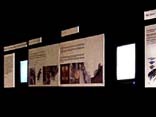 Installation at the Stazione Leopolda, Florence (photo by: Omar Cotza) |
||||
| Wholism
and Intricacy (Fall 02, Winter 03, and Spring 03) Instructor: Greg Lynn |
||||||
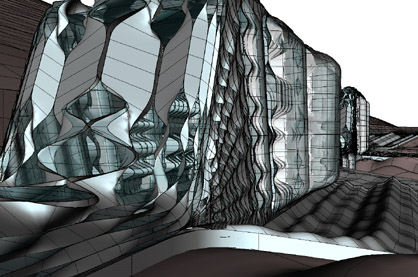
Wholism and Intricacy. Project by Sven Neumann "Wholism and Intricacy" research studio examines the term intricacy based on terms such as fold, braid, complex, plexus and imbricate. These morphologies of fusion and proliferation, and the philosophical sensibilities that inform them, are of primary interest. I have been theorizing the quality of intricacy in terms of design and historical analysis for the last 10 years and this course will be suffused with the term both theoretically, technically and formally. This studio relies on recent machinic architectural design techniques related to calculus based definitions of geometry and dimension, topology and surface modeling, animation, statistical visualization and CNC manufacturing. The geometric medium of the studio is topology and the dimensional medium is calculus. These technologies allow students to consider the design of various elements and manufacture proposal prototypes directly from digital models. The resulting series of investigations each respond to previously generated artifacts, each building knowledge based on the previous discovery. The course focused on two tasks: (1) developing expertise in the calculus based digital tools that are the necessary medium for the design and creating of any intricate assembly; and (2) applying these techniques to the analysis of modern historical precedent that are susceptible to intricate analysis using calculus based surface modeling tools. These precedents were not conceived with, nor do they anticipate analysis by, topology. Yet, the models are selected for their ability to yield successful results of intricacy when subjected to the following analysis through surface modeling: (1) massing and ground, (2) structure, (3) fenestration and (4) panelization and decoration. Through this research students become discriminating and expert in the limited repertoire of digital design tools as well as becoming knowledgeable about recent historical precedent and related techniques for achieving architectural effects through the use of these new techniques. Culminating in the spring with applying the resulting techniques students examined the Eames House, designed by Charles and Ray Eames as part of the Case Study House program for their final project. |
Greg Lynn is principal of Greg Lynn FORM. Lynn has taught throughout the United States and Europe. In addition to being a studio professor at UCLA he is the Davenport Visiting Professor at Yale University and o. Univ. Prof. at the University of Applied Arts in Vienna. Lynn was previously a professor at the ETH in Zürich and Columbia University. His architectural designs have received numerous awards and his work is regularly exhibited internationally in both architecture and art museums. He is a member of United Architects with whom he has participated in the Site Design Competition for Ground Zero as well as the invited competition for the new headquarters for the European Community Bank in Frankfurt Germany. Lynn writes and lectures widely on architectural design and theory. He is the author of Folds, Bodies, Blobs: Collected Essays (La Lettre Volée), Animate Form (Princeton Architectural Press), and the forthcoming Embryological House (Princeton Architectural Press). | |||||
| Intensive
Expansion: Strategies for the exfoliation of interior surfaces (Spring
2003) Instructor: Jason Payne |
||||||
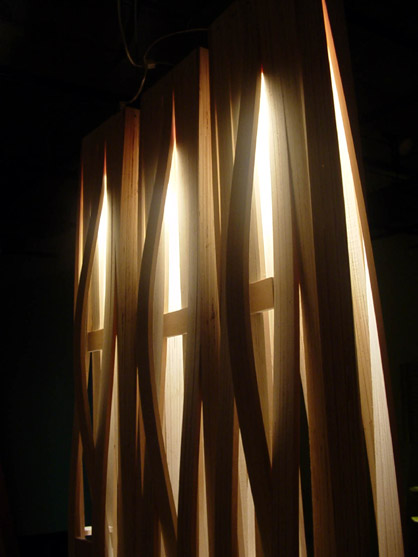
Intensive Expansion: Strategies for the exfoliation of interior surfaces. Project by Katerina Zisimopolou, Alex Fragkiadakis All too often the expression of interior architectural surfaces is muted due to the perceived limitations of common partition wall construction in standard practice these walls are meant to "go away," to recede behind the structure, spaces, and objects considered more central to the formation of the room they define. The latent geometries and materialities of these composite systems -studs sandwiched between sheetrock- are rarely mined for potentials more ambitious than the neutral white backdrop. It is possible, however, to cull new systemic possibilities from these elements through the development of their intrinsic logics in combination with the incorporation of extrinsic material dynamics. This reinvigoration of the partition wall through geometrical, structural, material, and programmatic expansion reasserts its presence and role in the definition of interior space. The course looks at the development of a series of layered geometries that correlate rhythmically. These mats of geometry are gradually pulled into three dimensions. During the thickening process, a 4'x 8' expanse of typical partition wall construction is developed and described in terms of its geometric and material potentials while downplaying its standard structural association, building materials and limited spatial roles. Its attributes are described not as "gypsum board, " "studs," "screws," "tape and spackle," etc., but rather in terms of directionalities, dimensionalities, potentials for change, resistance between materialites, and so on. This produces a charged bed of geometrical and material conditions within which the initial, extrinsically developed systems are submerged. Interconnections between these are discovered and developed. At various points within the process programmatic potentials emerge and are seized upon for further, more directed development. |
Jason Payne has taught at Rice University, Pratt Institute, and Rensselaer Polytechnic Institute. He has worked as project director for Reiser+Umemoto Architects and Daniel Libeskind Studio. As a co-principal of Payne Roberge Architects, established in 1998, he pursues both built and speculative projects. The office’s work is informed by intensive research and an experimental approach primarily involving the application of material dynamics to the organization of form. Promoting a new materialism, this work exploits the organizational and spatial potentials of the flows of after and energy that constitute our environment. | |||||
| Programmed
Structures (Winter 2003) Instructor: Neil Denari |
||||||
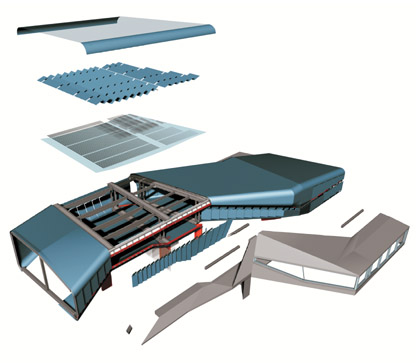
Programmed Structures. Project by Ben Mickus The development of architecture via 3D modeling software gives rise to a variety of working methods and attendant cultural positions in the field. Where the software allows one to manipulate geometry with greater degrees of both freedom and precision, it is in relation to various external parameters that the software becomes a fluid and methodical environment to work within. Through computer exploration this studio examines the basic conditions of program, statics, structure, and climate as a set of limitations/possibilities to produce a hyper-precise building. Space, programmatic specificity, material reality, and ecology are the studios primary concern. Structure in architecture can be deployed in many ways. At the beginning of the design process as an organizer of geometry and space, structure is usually a repetitive system of components and bay sizes. It can also be completely post engineered to fit any eccentric surface model design. Exploring both of these methods and others with specific projects of short duration will focus on the issues of typology of structure viz., column/beam and space frame systems and how each deals with span, space, maximization, and customization. Focusing primarily on steel as a flexible framing material the studios main concern is that the tectonic/structural nature of the building is fully integrated with the programmatic/cultural logics at work. The program of the house is one part exhibition gallery (public) for several works of Andreas Gursky and Thomas Struth and the other is a residence (private) for the chief curator of Documenta 12 held in Kassel , Germany in the Summer 2007. The residences interest in these artists stems from the architectural subject matter of the images and the implications of scale, globalisation, and the rituals of culture as manifested in cities and buildings. |
Neil Denari, AIA, is principal of NMDA, Neil M. Denari Architects Inc., Los Angeles and Denari+Tuczek Architects, Berlin. Recent work includes a showroom for l.a. Eyeworks in Los Angeles and competition entries for museums in Japan, Ireland, and Korea. NMDA is currently working on the International Center for Living Watersheds, a center for water research along the Cumberland River in Nashville, a 23 acre Master Plan also in Nashville, and a 71,000 sf office and theater interior for Endeavor, the 3rd largest talent agency in the world. From 1997-2001, Denari was the Director of SCI-Arc. In 2002, he received the Richard Recchia Award and the Samuel F.B. Morse Medal for architecture from the National Academy of Design in New York for distinguished work in the field. He is the author of Gyroscopic Horizons (Princeton Architectural Press, 1999). | |||||
| Navigating
The Exhibition (Fall 2002) Instructors: David Erdman with Ulrika Karlsson |
||||||
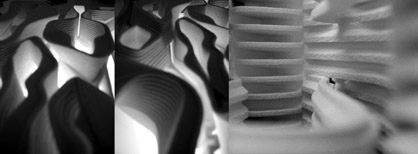
Navigating The Exhibition. Project by Alexander Lehnerer, Louise Griffin Guided by an exhibition, which collects video arts, fine art artists and multi media artists, the design focused on techniques for developing territories between the work collected with a particular emphasis on the conceptual blending of urban theory and exhibition design. The exhibition considers a mapping, that which provokes enigmatic and unanticipated territories between artists’ work. Analyzing and considering various examples of circulatory typology students challenged the notions of an exhibition as a concise pedagogical device with an "agenda" and re-think its structure under the terms of an experiential and immersive operand. The technological aspects of the studio focused on using technology to provide rapid prototyping -a 3D printer- as a learning tool rather that a representational device. Students primarily use the medium of 3D printing, modeling digitally, to consider typologies of circulation and distribution in the formulation of an exhibition design proposal for two sites. The output of multiple 3D models/diagrams explores as a tactile way to quickly repeat, re-feed, and re-calibrate models. Exploring modeling techniques students developed the following conditions: Archipe_logic. Stucture of circulation/distribution/navigation taking into consideraton issues of flow and directionality. Provoking alternative navigations which question how we read/navigate the city-read/navigate the gallery; Immersion. Located within as opposed to without. Developing local (immediate) or regional (semi-immediate) readings in contrast to global ones (the overview). |
David Erdman and Ulrika Karlsson are two of the founding members of the research and design collaborative servo. With a studio in Los Angeles and partners in New York, Stockholm, and Zürich, servo has exhibited and lectured widely. Servo was awarded the Young Architects Award by the Architectural League in New York in 2001, an IASPIS residency in Stockholm in 2002, and recently participated in Archilab 2002 Orleans International Architectural Conference. | |||||
| site
hosted by ARCH'IT rivista digitale di architettura www.architettura.it |
||||||
